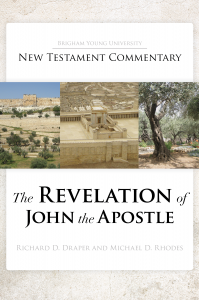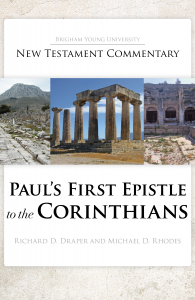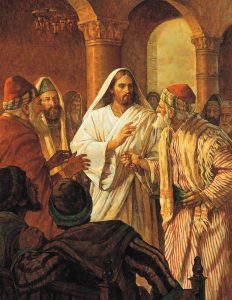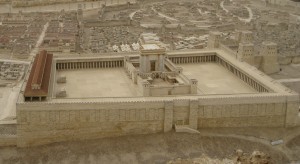By S. Kent Brown
For Latter-day Saints, Luke chapter 21 presents readers with one of seven versions of Jesus’ sermon on the Mount of Olives. Naturally, we know the versions that are presented in Mark 13 and Matthew 24–25. But there are more. We first notice that the Joseph Smith Translation completely freshens the reports of the sermon preserved by Mark and Matthew with a large number of changes that render their records largely the same; fewer adjustments appear in Luke 21. In each of the JST versions of Matthew, Mark, and Luke, the alterations bear on the meaning and thrust of Jesus’ words. Thus far, we see six versions—those in the three synoptic Gospels and those in the JST version of those Gospels, one of which is partially reported in Joseph Smith—Matthew of the Pearl of Great Price. The seventh record of the sermon lies in Doctrine and Covenants 45:16–59. As a preface, the Lord tantalizingly declares that “I will speak . . . and prophesy, as unto men in days of old. And I will show it plainly as I showed it unto my disciples as I stood before them in the flesh” “upon this mount,” the Mount of Olives (D&C 45:15–16, 48). With these words, we learn the vivid detail that Jesus imparts in the sermon while standing before his disciples, as a distinguished teacher, not sitting with them as Matthew 24:3 and Mark 13:3 lead us to believe.
In contrast to Mark 13 and Matthew 24–25, Luke chapter 21 provides two delectable dishes, not just one, ending with crowds still seeking Jesus’ company (see Luke 21:38). The first small dish consists in the refreshing story of a poor widow’s two mites, complete with tasteless displays of wealth that contrast with her tiny gift to the temple that glows with her adoring devotion (see Luke 21:1–4). Why is this story in this place? Possibly because of Mark’s placement of it just before the Savior’s sermon on the future (see Mark 12:41–44). On this view, the fact that Luke includes this story here may demonstrate a dependence on Mark’s order of events for Jesus’ last week. Perhaps significantly, Matthew omits the story, effectively dulling the notion that Mark serves as Luke’s main or only source for Jesus’ last days in Jerusalem, including the sermon on the Mount of Olives. Another possibility glimmers in front of us: Jesus’ mention of “widows’ houses” in the foregoing (Luke 20:47) may instead form a verbal bridge that brings the widow’s story here, pointing to a catchword association, a feature that may also infuse Mark 12:40–42.
But why recount this story about the widow before rehearsing the sermon about the fate of Jerusalem and its citizens? Because, after a first glance, her story brings together a raw, untouched comparison between her situation and the gleaming opulence of both the temple and its contributors, the latter offering a practiced yet worn piety that will not save the temple from destruction. In addition, we sense that, while the temple’s importance remains strong in the minds and hearts of even the poor, its officials and major contributors are out of touch with common persons, rudely flaunting their wealth in their presence. Such a perception may also give flavor to Jesus’ prior talk about those who “devour widows’ houses” (Luke 20:47).
In the eschatological discourse on the Mount of Olives, the second and longest part of this chapter that rehearses Jesus’ grand and often frightful vision of the future (see Luke 21:5–36), the words of Jesus stir together a number of prophecies that appear elsewhere in Luke’s Gospel. The list is short: the exhortations to watch (see Luke 12:35–48; 21:34–36; especially JST 12:35–57); the warnings about deceptions (see Luke 17:20–24; 21:8–9); the desolation that stalks Jerusalem (see Luke 13:34–35; 21:20–24; JST 13:35–36); and the signs of the Second Coming (see Luke 17:26–37; 21:25–28; JST 17:26–40). The main question is whether the Savior indeed speaks such words away from Jerusalem, as Luke reports Jesus’ teachings. The answer is Yes, as both the JST version of Luke 12:41–45 and Jesus’ declarations about Jerusalem’s fate and the future kingdom make abundantly clear (see Luke 13:33–35; 17:20–37). Hence, we should see Jesus’ discourse on the Mount of Olives as one wherein he brings together sayings uttered on other occasions, along with fresh prophecies, and shapes them into a whole piece that addresses the issues of the future of Jerusalem, of the disciples, and of the end-time.
In light of the Savior’s introduction to the sermon preserved in modern scripture, “As ye have asked of me concerning the signs of my coming” (D&C 45:16), no compelling reason exists to suppose that it is Luke who selects some of these sayings from their original setting in this sermon and inserts them into other, earlier contexts, or vice versa. Even so, we find what may be hints that Luke pens his version of the sermon after the Jewish War (AD 66–70), for he tops it with the vivid notation, “ye shall see Jerusalem compassed with armies” (Luke 21:20; also 19:43). The other accounts omit this detail. Instead, they feature the “abomination of desolation” (Matt. 24:15; Mark 13:14), an expression from the book of Daniel which the Joseph Smith Translation interprets as “the destruction of Jerusalem” (JST Matt. 24:12; JST Mark 13:14; see Dan. 9:27; 11:31; 12:11). This said, reasons exist to question the scholarly insistence that Luke writes in hindsight, after the end of the war.
This view of the discourse does not enjoy widespread support. Many see the sermon as a collection of disparate sayings that Mark, the first Gospel writer, artfully stitches together into an absorbing sermon that simply reflects the major concerns in the primitive church’s preaching, that is, warnings against false Christs and prophets, the sufferings of believers, the judgment upon Jerusalem, and the requirement of disciples to watch for Jesus’ return. In this view, much of the sermon illumines Jesus’ teachings, but Mark alone, or his source, is responsible for its ordering and flavoring, or even its composition.[1] For Latter-day Saints, both the inspired changes introduced into the Joseph Smith Translation of the synoptic Gospels and the first-hand account of the sermon that the Savior rehearses in Doctrine and Covenants 45:16–59 stand firmly against such a view. Instead of Mark presenting a table of teachings based on the church’s preaching interests, it seems more likely that it is Jesus’ words in the sermon that set the agenda for those interests.
In a completely different vein, this sermon will save the lives of uncounted disciples who, knowing of Jesus’ warnings about the fall of Jerusalem and its temple, will flee from the capital city which becomes the headquarters of the church in its early days. Rather than retreat into the city for safety, as thousands do when war breaks out with Rome late in AD 66 and again when Roman armies approach Jerusalem’s gates in AD 70, Christians flee northward, many of them settling in a gentile town, Pella, on the east bank of the Jordan River. There they wait out the war and survive intact.
This text is extracted from S. Kent Brown, The Testimony of Luke, 929–932.
[1]Bultmann, History, 125; Francis W. Beare, The Earliest Records of Jesus (New York: Abingdon Press, 1962), 216; Fitzmyer, Luke, 2:1323–25; George R. Beasley-Murray, Jesus and the Last Days: The Interpretation of the Olivet Discourse (Peabody, Mass.: Hendrickson Publishers, 1993), 350–65.
 ge book is comprehensive—it covers all the key themes of the biblical book of Revelation phrase by phrase, and when necessary, word by word. It also treats numerous pertinent details with careful explanations. The documentation is extensive, thorough and precise. Of particular value is the incorporation of pertinent historical information that adds meaning and aids the reader’s understanding of what the apostle John has written. While presenting numerous additional insights which have been made known to Latter-day Saints, the book also points out the viewpoints, finding and alternate interpretations of scholars from other faiths.
ge book is comprehensive—it covers all the key themes of the biblical book of Revelation phrase by phrase, and when necessary, word by word. It also treats numerous pertinent details with careful explanations. The documentation is extensive, thorough and precise. Of particular value is the incorporation of pertinent historical information that adds meaning and aids the reader’s understanding of what the apostle John has written. While presenting numerous additional insights which have been made known to Latter-day Saints, the book also points out the viewpoints, finding and alternate interpretations of scholars from other faiths.



